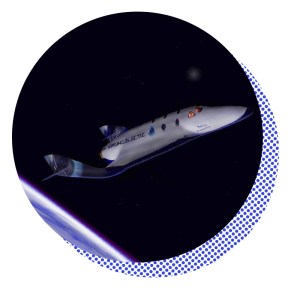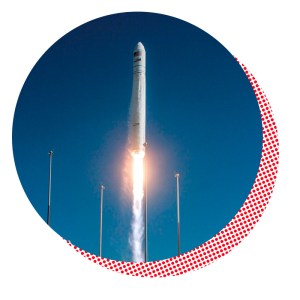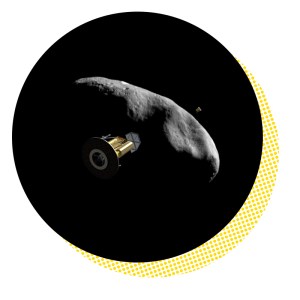
Xaero. Stratolauncher. Atlas V. Dream Chaser. If you built a spaceship, wouldn’t you name it something awesome too? These four spacecraft, and many more, are detailed in a recent report in which NASA examines the evolving landscape of spaceflight. As the authors admit, the space agency’s own budgets are shrinking, so companies and individuals are critical to the growing space economy. Take a look at these incredible machines from 18 firms, both established and entrepreneurial, that NASA thinks might help lead our space-bound charge.
Blue Origin
Spacecraft: New Shepard; Bionic Spacecraft

Owned by Amazon founder Jeff Bezos, Blue Origin is all about lowering the cost of spaceflight so that many more humans can head to space. For now, this long-term effort means developing reusable launch vehicles that use Vertical Takeoff, Vertical Landing (VTVL) technology. The firm’s New Shepard system will carry three astronauts to conduct experiments in suborbital space; plans include launching an orbital program to push past Earth’s gravity. Image of New Shepard: Phil Smith/NASA.
Masten Space Systems
Spacecraft: Xaero, Xogdor

Founded in 2004, Masten brings practices familiar to software designers (iteration and reusability) to the space world. Its goal: to lower the barriers to space access. To date, its reusable rockets have flown more than 300 flights, while in July 2014 the company won a DARPA contract to develop a reusable launch vehicle for the Experimental Spaceplane program. Image of Xaero: Masten Space Systems.
Virgin Galactic
Spacecraft: SpaceShipTwo, LauncherOne

Despite the tragic crash of SpaceShipTwo in October 2014, Virgin Galactic founder Richard Branson wrote in February 2015 that the company is “undeterred in our commitment to meeting our goals.” Namely, to connect Earth to space. Branson continued: “We believe that exploring space will make life better on Earth — a broader perspective is crucial to solving our planet’s greatest challenges.” Image of SpaceShipTwo: Phil Smith/NASA.
XCOR Aerospace
Spacecraft: Lynx

The Lynx series of suborbital vehicles will take humans and payloads on a half-hour suborbital flight up to 330,000 feet (and then back to Earth). Tickets are already on sale — in fact, one of our TED-Ed animators won one. Not a competition winner yourself? A ticket to join the pilot on Lynx Mark I costs $95,000. Image of Lynx: XCOR Aerospace.
Orbital Sciences Corporation
Spacecraft: Pegasus, Taurus, Antares, Cygnus

A $5 billion company with 3,600 employees, Orbital has been in business since 1982, and it works in a range of space-related areas. For instance, it is under contract with NASA to deliver 20,000 kilograms of cargo to the International Space Station on the Cygnus spacecraft. In October 2014, a $200 million unmanned Antares rocket heading to resupply the ISS exploded seconds after launch. Image of Antares: Orbital Sciences Corporation.
SpaceX
Spacecraft: Falcon 9, Falcon Heavy, Dragon

“The goal of SpaceX is to try to advance rocket technology, and in particular to try to crack a problem that I think is vital for humanity to become a space-faring civilization, which is to have a rapidly and fully reusable rocket,” said Elon Musk in his 2013 TED Talk, The mind behind Tesla, SpaceX, SolarCity …. Under a $1.6 billion contract with NASA, the Hawthorne, California-based company is due to fly at least 12 cargo resupply missions to the International Space Station — with human passengers the next goal. Image of Dragon: NASA.
Stratolaunch Systems
Spacecraft: Stratolauncher

Founded by Microsoft cofounder Paul Allen, Stratolaunch is putting together a formidable team of aerospace bigwigs. Burt Rutan (TED Talk: The real future of space exploration) and his firm, Scaled Composites, will build a carrier aircraft; Orbital Sciences Corporation will work on launch vehicles and boosters. “Stratolaunch’s goal is to reduce the cost of access to space with air-launched rockets at a scale previously deemed impossible,” write NASA’s authors. “The custom carrier will have the longest wingspan of any aircraft ever built.” Image of Stratolauncher: Stratolaunch Systems.
United Launch Alliance
Spacecraft: Atlas V, Delta IV

A joint venture between aerospace giants Boeing and Lockheed Martin, United Launch Alliance provides launch services to the U.S. government. In January 2015, a Delta II vehicle launched with the SMAP mission to monitor Earth’s surface soil moisture. In March, it’s set to send four spacecraft to work on the Magnetospheric Multiscale mission to study how magnetic fields around Earth connect and disconnect; that will be the 94th launch since the company was founded in 2006. Image of Atlas V: United Launch Alliance.
Planet Labs
Spacecraft: Dove, Flock 1

“Satellites are big, expensive and slow,” said Will Marshall in his TED Talk (Tiny satellites show us the Earth as it changes in near-real-time). He and some friends founded Planet Labs to do things differently, making satellites that are ultra-compact and can provide on-demand imagery. Flock 1, comprising 28 Dove satellites, was launched in January 2014; there are now 71 Doves photographing the Earth. Image of Flock 1: Planet Labs.
Skybox Imaging
Spacecraft: SkySat

Former NASA engineer Dan Berkenstock (TED Talk: The world is one big dataset. Now, how to photograph it …) co-founded Skybox Imaging to, as he puts it, “approach daily global activity as the world’s largest data science problem.” The company’s Cube-Sat satellites, cheap to build, are about the size of a phone book and consume less power than a 100-watt lightbulb, while delivering sharp, timely, still and video images. In August 2014, Skybox was acquired by Google. Image of SkySat: Skybox Imaging.
Bigelow Aerospace
Spacecraft: B330

The B330 is an expandable space habitat, with some 12,000 cubic feet of internal space. Bigelow licensed the technology from NASA after Congress canceled the wildly over-budget TransHab program in 2000. Built to support scientific missions, the inflatable platform might also work for space tourism or on missions destined for the Moon or Mars. The NASA authors report that Bigelow is due to test an inflatable platform on the International Space Station in 2015. Image of B330: Phil Smith/NASA.
Boeing
Spacecraft: CST-100

We all know Boeing … but we might not all know Boeing’s forays into space. Its latest introduction is the crewed capsule, the CST-100, designed to transport up to seven passengers to the International Space Station and to other space stations. The first crewed flight to the ISS is due to take off in mid-2017. Image of CST-100: Boeing/NASA.
Sierra Nevada
Spacecraft: Dream Chaser

The Dream Chaser is a reusable, winged spacecraft that will take seven crew to and from the ISS. It’s about a quarter of the length of the existing space shuttle, and it’s designed so it can land at most commercial airports. It’s specifically engineered for simple maintenance and quick turnaround; Sierra Nevada estimates that it will take about 60 days to get the vehicle ready for another flight. Image of Dream Chaser: Sierra Nevada Corporation.
Space Adventures
Spacecraft: Soyuz

Founded in 1988, Space Adventures is the only company currently offering “space tourism.” To date, its passengers have spent nearly three months in suborbital spaceflight, traveling over 36 million miles at about 100 kilometers above Earth, at the boundary between the planet’s atmosphere and space. Its first circumlunar mission is due to take off by 2018, and will take two paying customers to within 100 kilometers of the moon. Image of Soyuz: NASA.
B612 Foundation
Spacecraft: Sentinel

Astronaut Ed Lu founded the nonprofit B612 Foundation after being challenged by a Google employee to discover and track hundreds of thousands of potentially Earth-destroying asteroids. The nearly seven-year mission will catalog 90% of asteroids larger than 140 meters; the Sentinel Space Telescope will make like Venus as it orbits around the sun. Image of Sentinel: B612Julie / CC BY-SA 4.0.
Inspiration Mars
Spacecraft: Inspiration Mars

In 2018, Inspiration Mars hopes to offer a once-in-every-15-years opportunity: to fly to Mars and back. Sure, the trip will take nearly two years (501 days, to be precise) and only two people (one man, one woman) can go, but the nonprofit hopes that the trip will ignite a new passion for space travel. “NASA and America’s space program have been a critical part of inspiring our nation and people everywhere to reach for their dreams and dare to invent their future,” reads a company blurb. “The Inspiration Mars Foundation is committed to moving America farther and faster toward our destiny as the world leaders in technical innovation, science, exploration and discovery.” Image of Inspiration Mars: Inspiration Mars.
Moon Express
Spacecraft: Moon Express

“Moon Express‘ long-term goal is to enable commercial mining on the Moon,” write NASA’s report authors. Founded in 2010, the company is developing robotic spacecraft, with a technology demonstration due later in 2015. The company’s landing technology just won a $1 million “milestone prize” as part of the Google Lunar X Prize, and netted another $250,000 prize for imaging; it’s all in the race to the grand prize, a $20m purse to be awarded for a Moon landing before Dec. 31, 2016. Image of Moon Express: Moon Express.
Planetary Resources
Spacecraft: Arkyd 100, Arkyd 200, Arkyd 300

“Planetary Resources is definitely a great example of ‘Having a healthy disregard for the impossible,’” remarks Google founder, Larry Page, who has invested in the company. Known as the “asteroid mining company,” the company is developing a network of orbital telescopes to prospect for valuable near-Earth asteroids. For instance, finding water on asteroids could fuel an in-space economy by creating the means to make rocket fuel and consumable water from space, for space. Image of Arkyd: Planetary Resources.
Animated gif by Cesar Pelizer for TED.












